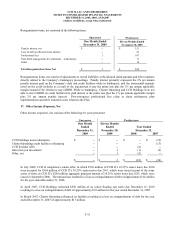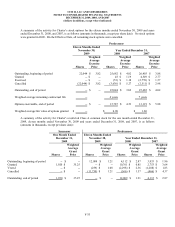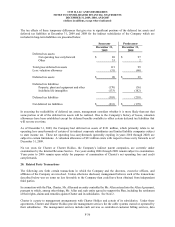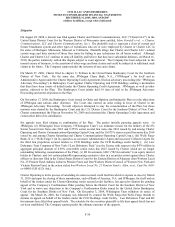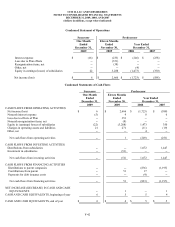Charter 2009 Annual Report Download - page 88
Download and view the complete annual report
Please find page 88 of the 2009 Charter annual report below. You can navigate through the pages in the report by either clicking on the pages listed below, or by using the keyword search tool below to find specific information within the annual report.CCH II, LLC AND SUBSIDIARIES
NOTES TO CONSOLIDATED FINANCIAL STATEMENTS
DECEMBER 31, 2009, 2008, AND 2007
(dollars in millions, except where indicated)
F-40
The Company and its parent companies are party to lawsuits and claims that arise in the ordinary course of
conducting its business. The ultimate outcome of these other legal matters pending against the Company or its
parent companies cannot be predicted, and although such lawsuits and claims are not expected individually to have a
material adverse effect on the Company’ s consolidated financial condition, results of operations or liquidity, such
lawsuits could have, in the aggregate, a material adverse effect on the Company’ s consolidated financial condition,
results of operations or liquidity.
Regulation in the Cable Industry
The operation of a cable system is extensively regulated by the Federal Communications Commission (“FCC”),
some state governments and most local governments. The FCC has the authority to enforce its regulations through
the imposition of substantial fines, the issuance of cease and desist orders and/or the imposition of other
administrative sanctions, such as the revocation of FCC licenses needed to operate certain transmission facilities
used in connection with cable operations. The 1996 Telecom Act altered the regulatory structure governing the
nation’ s communications providers. It removed barriers to competition in both the cable television market and the
telephone market. Among other things, it reduced the scope of cable rate regulation and encouraged additional
competition in the video programming industry by allowing telephone companies to provide video programming in
their own telephone service areas.
Future legislative and regulatory changes could adversely affect the Company’ s operations, including, without
limitation, additional regulatory requirements the Company may be required to comply with as it offers new services
such as telephone.
22. Employee Benefit Plan
The Company’ s employees may participate in the Charter Communications, Inc. 401(k) Plan. Employees that
qualify for participation can contribute up to 50% of their salary, on a pre-tax basis, subject to a maximum
contribution limit as determined by the Internal Revenue Service. For each payroll period, the Company contributed
to the 401(k) Plan (a) the total amount of the salary reduction the employee elects to defer between 1% and 50% and
(b) a matching contribution equal to 50% of the amount of the salary reduction the participant elects to defer (up to
5% of the participant’ s payroll compensation), excluding any catch-up contributions. The Company made
contributions to the 401(k) plan totaling $1 million, $7 million, $8 million, and $7 million for the one month ended
December 31, 2009, eleven months ended November 30, 2009 and years ended December 31, 2008, and 2007,
respectively.
Effective January 1, 2010, the Company’ s matching contribution will be discretionary with the intent that any
contribution be based on performance metrics used in its other bonus and incentive plans. The discretionary
performance contribution will be made on an annual basis (instead of on a per pay period basis). Each participant
who makes before-tax contributions and is employed on the last day of the fiscal year will receive a portion of the
discretionary performance contribution, if any, on a pro rata basis. The Company will divide each participant’ s
before-tax contributions for the year (up to 5% of eligible earnings, excluding catch-up contributions) by the total
employee contributions (up to 5% of eligible earnings, excluding catch-up contributions) for the year to determine
each participant’ s share of any discretionary performance contribution.
23. Recently Issued Accounting Standards
In December 2007, the FASB issued guidance included in ASC 810-10, Consolidation – Overall (“ASC 810-10”),
which provides guidance on the accounting and reporting for minority interests in consolidated financial statements.
ASC 810-10 requires losses to be allocated to noncontrolling (minority) interests even when such amounts are
deficits. This guidance included in ASC 810-10 is effective for fiscal years beginning after December 15, 2008.
The Company adopted this guidance included in ASC 810-10 effective January 1, 2009 and applied the effects
retrospectively to all periods presented to the extent prescribed by the standard. The adoption resulted in the
presentation of Mr. Allen’ s previous 5.6% preferred membership interest in CC VIII as temporary equity and CCH
I’ s 13% membership interest in CC VIII as noncontrolling interest in the Company’ s consolidated balance sheets



